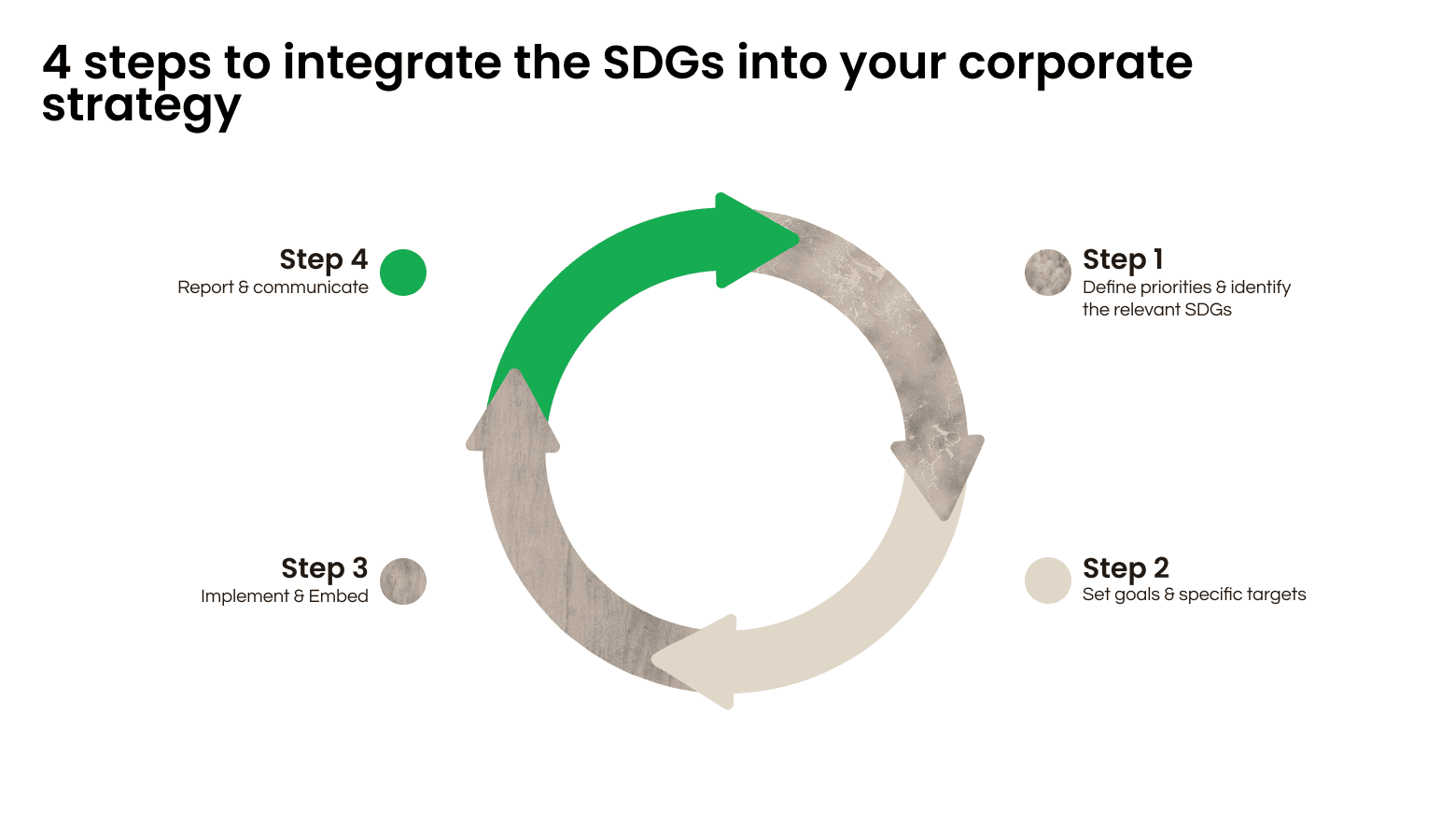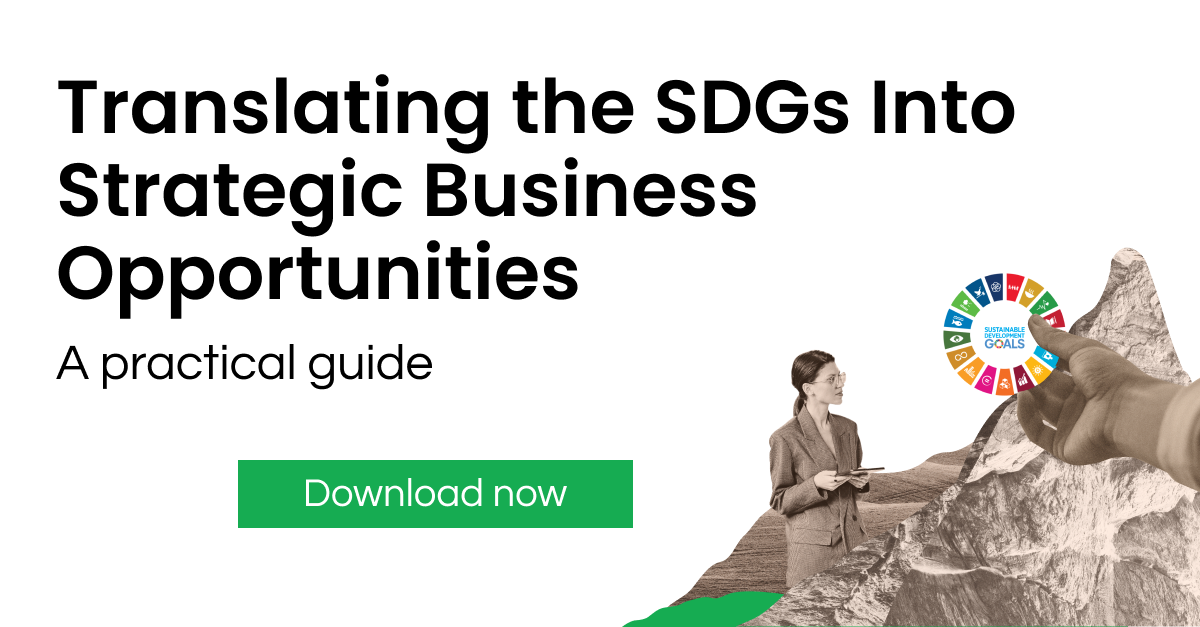4 Steps To Translate The SDGs Into Business Opportunities

Why should the Sustainable Development Goals matter to your organisation?
Adopted in September 2015 by the United Nations, the Sustainable Development Goals (SDGs) set 17 goals and 169 targets to be met by the global community by 2030. The mission and aspiration? End extreme poverty and ensure prosperity for all within the boundaries of the planet. In other words, they set guiding principles towards an inclusive and thriving society.

Businesses worldwide have an important role to play if this 2030 agenda is to be achieved and as disclosure and impact measurement practices are not centralized, the SDGs provide a north star and shared language for leaders to steer their organizations towards more sustainable business models.
The SDGs are a powerful way for you as an organization to make a public commitment to sustainable development and showcase how you are contributing to the shaping of a more resilient world.
As such, the SDGs provide a unique opportunity for businesses to identify, assess and demonstrate to their stakeholders how they are addressing the world’s biggest sustainable development challenges and are creating shared value.
Nonetheless, knowing where to start and taking that first step in aligning an organization’s strategy with the SDGs is a difficult task as a wide range of questions often arises, such as:
- How can I contribute to the SDGs?
- Which goals are most relevant to my organization?
- How should I set targets at the level of my organization and how do I measure my impact and monitor progress?
- What tools do I need for my SDG integration strategy to be effective?
The SDGs provide an opportunity for your business to:
- Identify new opportunities to become more resilient as an organization and make sure you are addressing future needs;
- Motivate employees through a shared purpose and mission;
- Attract funding opportunities by showcasing how you are minimizing negative impact and maximizing positive impact across material issues;
- Improve the credibility and effectiveness of your sustainability strategy and efforts through alignment with established and well-researched global needs;
- Strengthen stakeholder dialogue and relations and anticipate regulatory changes to minimize future risks;
- Consistently and effectively communicate and report on sustainability efforts to drive stronger partnerships.
4 steps to integrate the SDGs into your corporate strategy

Step 1: Define Priorities & Identify the Relevant SDGs
Defining your company’s priorities and focusing your efforts is key to benefit from the opportunities presented by the SDGs. To do so, one should consider how to minimize risks on civil society and the environment and identify beneficial SDG-related products, services, and investments.
To define priorities and identify relevant SDGs, it is important to:
- Map your value chain (downstream and upstream);
- Conduct a materiality assessmentthat identifies key impact areas as well as the issues that are most important to your organization and your stakeholders;
- Use a benchmarking tool or audit your value chain and operations;
- Consult important stakeholders and engage your senior team;
- Breakdown your strategic business priorities and define how they affect or are affected by the global goals;
- Avoid ‘SDG cherry-picking’ and ‘SDG washing’. This means focusing on real priorities rather than what is easiest and reporting as much on negative as positive impact.
All of these steps will enable you to ensure the SDGs you identify are aligned with your overall corporate strategy and existing operations.
Step 2: Set Goals and Specific Targets
Once you have defined your priorities, focused your efforts, and identified the applicable SDGs to guide your goals, it is time to set specific targets. These targets should cover priorities across the key sustainability pillars, including environment, ethics, labour, and human rights, and sustainable procurement, and act as strong proxies for impact. Each target should be set with a baseline in mind.
As the popular adage goes, you cannot improve what you cannot measure. Selecting specific indicators from recognized sources (such as GRI, CDP, or IRIS+) and defining what success means to your organization will permit you to remain focused and relevant while measuring your performance against the SDGs over time.
To set your targets and indicators, make sure they respect the following key principles:
- Specific and clear;
- Relevant and measurable;
- Ambitious yet realistic;
- Time-bound and transparent.
Step 3: Implement & Embed
As a result of goal and target setting, you will have developed specific KPIs that proxy for your organization’s impact on the SDGs. Now comes the stage where you need to make practical decisions about the best ways you can implement sustainable change within your organization. One common practice to avoid is the relabelling of existing efforts in SDG terms as that will often remain surface-level and will lose focus. Achieving the SDGs requires new and additional efforts.
Step 4: Report & Communicate
The fourth phase of the circular process consists of reporting and communicating progress on SDG-related targets, whether positive or negative.
Sustainability reporting and disclosure should be seen and adopted as a strategic tool to drive decision-making, open dialogue with stakeholders, attract investors and continuously re-assess impacts to steer the organization in the right direction.
To create quality disclosures, it is absolutely key to use internationally recognized standards and frameworks such as those offered by GRI, CDP, the Climate Disclosure Standards Board (CDSB) and The Greenhouse Gas Protocol, the UNGP Reporting Framework, UN Global Compact, and Integrated Reporting. You can find more information in our Sustainability Reporting eBook. In 2019, 95% of reports reviewed by the WBCSD acknowledged the SDGs in some way, 86% prioritized specific
SDGs and presented some evidence to back their claims but only 10% of reports set SMART targets to measure their progress on the goals.
Conclusion
The private sector has a vital role to play in ensuring the 17 Sustainable Development goals are delivered by 2030. By both contributing to and being impacted by grand challenges such as climate change and widening inequality, it is clearer than ever that organizations should proactively define how they adopt and embed sustainability within their company strategy. Doing so will create new strategic opportunities such as motivating employees, attracting new funding sources, strengthening stakeholder dialogue, and boosting innovation in goods and service provision.
To summarize, the goals provide a comprehensive framework that enables organizations to define and prioritize material issues and improve the quality of their reporting, sending a clear message to internal and external stakeholders alike. Following the four steps outlined in this article guides how to translate the SDG framework into strategic business opportunities and unlock significant value.

